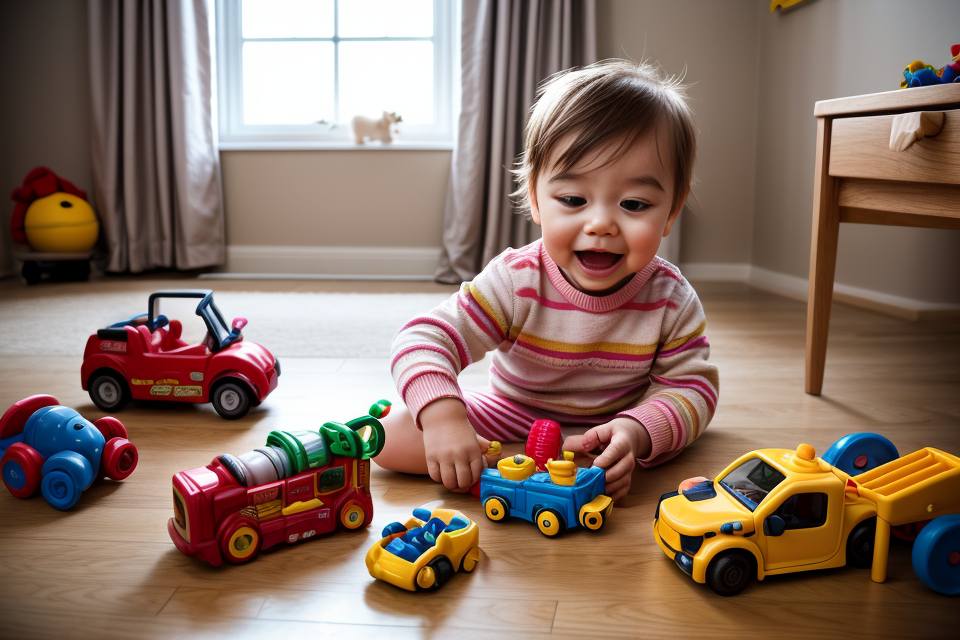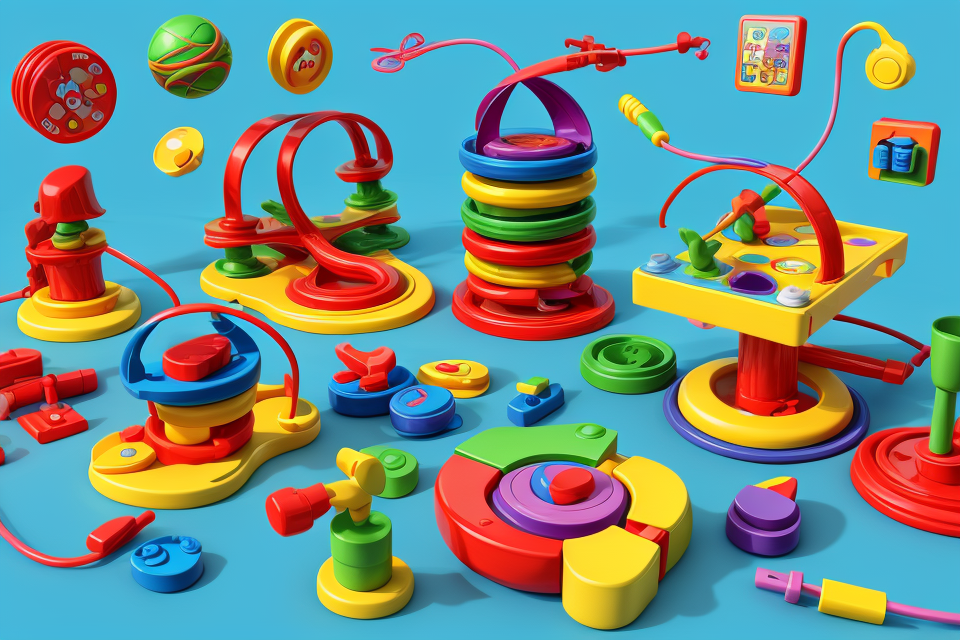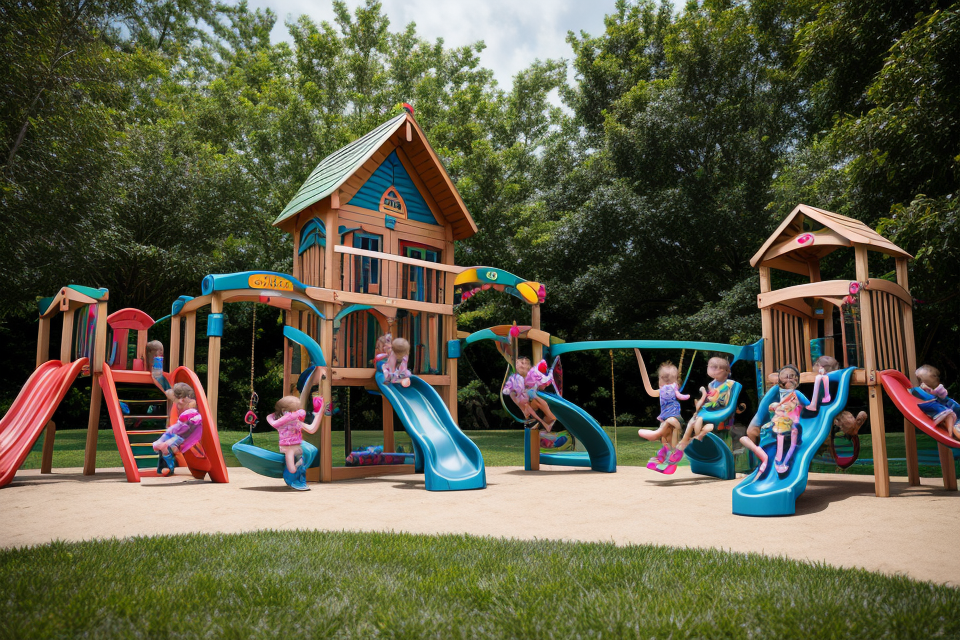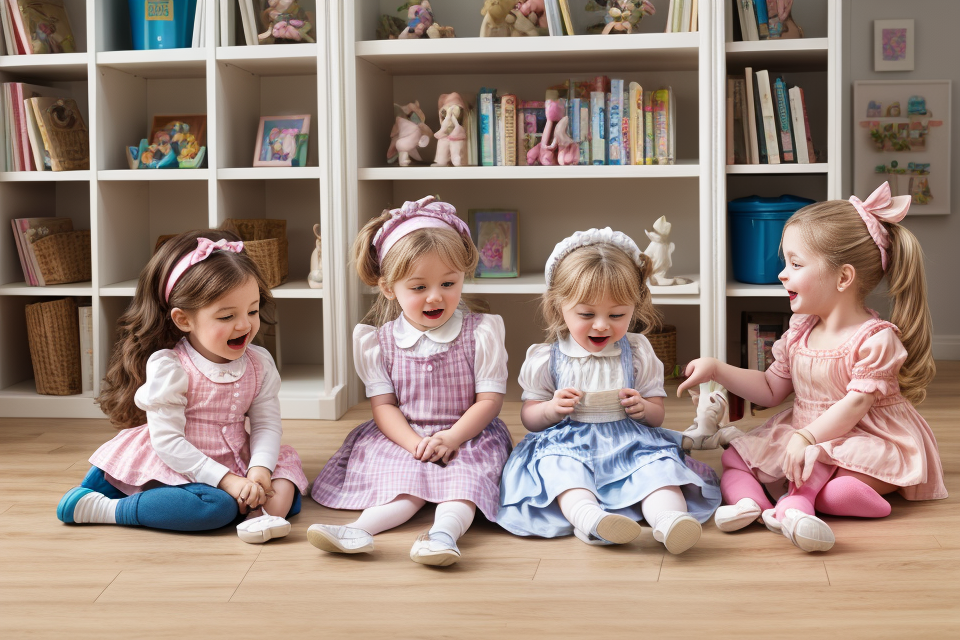
Toys are an essential part of childhood, providing hours of entertainment and sparking creativity. However, while toy play is generally considered beneficial, there are some potential drawbacks to consider. In this comprehensive analysis, we will explore the pros and cons of toy play, examining the potential disadvantages and their impact on children’s development. From a critical perspective, we will evaluate the role of toys in shaping a child’s imagination and exploring alternative forms of play. Join us as we delve into the world of toys and uncover the pros and cons of this timeless pastime.
Understanding the Importance of Toy Play
Benefits of Toy Play
Toy play is a crucial aspect of a child’s development, providing numerous benefits that can have a lasting impact on their overall growth and well-being. Some of the most significant benefits of toy play include:
Encourages Creativity and Imagination
One of the most significant benefits of toy play is that it encourages creativity and imagination. When children are given the opportunity to explore and play with toys, they are able to use their imagination and creativity to come up with new ideas and concepts. This type of play also helps children develop problem-solving skills, as they are often required to think outside the box and come up with unique solutions to challenges.
Enhances Cognitive Development
Toy play also plays a crucial role in enhancing cognitive development. When children engage in play, they are able to learn and understand new concepts, such as colors, shapes, and numbers. This type of hands-on learning also helps children develop critical thinking skills, as they are required to make decisions and solve problems while playing.
Supports Social and Emotional Growth
In addition to cognitive development, toy play also supports social and emotional growth. When children play with others, they are able to develop important social skills, such as sharing, cooperating, and communicating. Toy play also provides children with opportunities to express their emotions and learn how to manage them in a healthy way.
Fosters Physical Development
Finally, toy play also fosters physical development. Many toys, such as building blocks and action figures, encourage children to use their fine motor skills and hand-eye coordination. This type of play also helps children develop gross motor skills, such as balance and coordination, as they run, jump, and play games.
Overall, toy play provides children with a wide range of benefits that can have a lasting impact on their development. By encouraging creativity and imagination, enhancing cognitive development, supporting social and emotional growth, and fostering physical development, toy play is an essential part of a child’s growth and development.
Risks of Toy Play
While toy play offers numerous benefits for children’s development, it is crucial to recognize the potential risks associated with toy play. Some of the most common risks include:
- Exposure to Harmful Chemicals: Some toys contain harmful chemicals such as lead, mercury, and phthalates, which can pose serious health risks to children. These chemicals can affect children’s physical and cognitive development, and in severe cases, they can cause long-term health problems.
- Injuries and Accidents: Certain toys can be hazardous to children, causing injuries such as cuts, bruises, and broken bones. Additionally, toys with small parts can be easily swallowed or inhaled, leading to choking or asphyxiation.
- Overstimulation and Addiction: Too much exposure to toys can lead to overstimulation, which can result in behavioral problems such as aggression, hyperactivity, and attention difficulties. Furthermore, children may become addicted to certain types of toys, leading to a reliance on these toys for comfort and entertainment.
- Inadequate Supervision: Toy play requires adequate supervision to ensure that children are using toys safely and appropriately. However, many parents and caregivers fail to provide sufficient supervision, which can lead to accidents and injuries.
It is essential to recognize these risks and take appropriate measures to mitigate them. Parents and caregivers should ensure that toys are age-appropriate, and they should closely monitor children while they play with toys. Additionally, toys should be regularly inspected for any signs of wear or damage, and hazardous toys should be removed from children’s play areas immediately. By taking these precautions, parents and caregivers can help ensure that toy play remains a safe and enjoyable experience for children.
The Psychological Effects of Toy Play
Positive Psychological Effects
Increased Self-esteem
Toy play has been shown to have a positive impact on children’s self-esteem. Through play, children are able to explore their interests and abilities, which can boost their confidence and sense of self-worth. This can lead to a greater sense of self-efficacy and a more positive outlook on life.
Better Mental Health
Playing with toys can also have a positive effect on children’s mental health. Through play, children are able to express and process their emotions, which can help them develop emotional regulation skills. Additionally, toy play can provide a much-needed break from stress and anxiety, allowing children to relax and have fun.
Stronger Attachment to Caregivers
Toy play can also strengthen the attachment between children and their caregivers. When caregivers engage in play with children, it can foster a sense of closeness and bonding. This can lead to a stronger and more secure attachment relationship, which can have long-term benefits for both the child and the caregiver.
Greater Resilience
Finally, toy play can also help children develop resilience. Through play, children are able to practice problem-solving and coping skills, which can help them navigate difficult situations. Additionally, toy play can provide a sense of control and mastery, which can help children feel more confident and capable in the face of challenges.
Negative Psychological Effects
While toy play has numerous benefits, it is essential to consider the potential negative psychological effects it may have on children. Here are some of the adverse psychological effects associated with toy play:
Addiction and Withdrawal
Toy addiction, also known as compulsive buying or hoarding of toys, can lead to negative psychological effects such as anxiety, depression, and social isolation. Children who become addicted to toys may experience a sense of loss or despair when they are unable to obtain a particular toy, leading to feelings of frustration and anger. Moreover, toy addiction can interfere with a child’s ability to form healthy relationships and participate in social activities.
Aggression and Violence
Excessive exposure to violent toys and games can lead to aggressive behavior in children. Research has shown that children who play with violent toys are more likely to engage in aggressive behavior, such as hitting, pushing, and biting. Moreover, exposure to violent toys can desensitize children to violence, making them less empathetic and more accepting of violent behavior.
Escapism and Withdrawal
Toy play can also lead to escapism and withdrawal from reality. Children who spend excessive amounts of time playing with toys may become detached from the world around them, leading to social isolation and a lack of interest in other activities. This can result in a failure to develop important social skills, such as communication, empathy, and cooperation.
Reduced Social Skills
Playing with toys for extended periods can also lead to reduced social skills. Children who spend too much time playing with toys may struggle to interact with others, leading to difficulty in forming friendships and participating in group activities. Moreover, excessive toy play can result in a lack of imagination and creativity, as children may become reliant on toys to stimulate their imagination rather than using their own creativity.
Overall, while toy play has numerous benefits, it is important to be aware of the potential negative psychological effects it may have on children. By understanding these effects, parents and caregivers can ensure that toy play is balanced with other activities that promote healthy development.
The Physical Effects of Toy Play
Positive Physical Effects
- Enhanced Fine Motor Skills
- Toy play, particularly with manipulatives and building sets, can improve fine motor skills in children. This is because these activities require the use of small muscles in the hands and fingers, which can help develop dexterity and coordination.
- Research has shown that children who engage in regular toy play have better hand-eye coordination and are able to perform tasks that require precision and accuracy more easily.
- Examples of toys that can enhance fine motor skills include puzzles, Legos, and playdough.
- Increased Strength and Coordination
- Toy play can also improve physical strength and coordination in children. This is because many toys require active movement and can promote physical activity, which is important for overall health and development.
- For example, toys such as action figures, cars, and sports equipment can encourage children to engage in imaginative play that involves running, jumping, and throwing, which can help build physical endurance and coordination.
- Additionally, toys that require manipulation, such as stuffed animals or dolls, can help improve hand-eye coordination and fine motor skills.
- Improved Cardiovascular Health
- Regular physical activity, such as that promoted through toy play, can improve cardiovascular health in children. This is because it can help strengthen the heart and improve circulation, which can reduce the risk of heart disease later in life.
- Toy play that involves running, jumping, and other forms of active play can help increase heart rate and improve overall cardiovascular fitness.
- Additionally, toys that promote outdoor play, such as bicycles or scooters, can provide additional benefits for cardiovascular health.
- Greater Exposure to Nature
- Many toys, particularly those that promote outdoor play, can provide children with greater exposure to nature. This can have a positive impact on physical and mental health, as well as fostering a sense of connection to the natural world.
- Examples of toys that can promote exposure to nature include camping gear, binoculars, and bug catchers.
- Additionally, toys that encourage outdoor play, such as bicycles or scooters, can provide opportunities for children to explore and appreciate the natural environment.
Negative Physical Effects
- Overuse Injuries
Overuse injuries refer to the strain or damage caused to muscles, tendons, or other soft tissues due to repetitive or prolonged use of toys. This can lead to pain, inflammation, and even long-term disability if left untreated. Children who engage in prolonged or vigorous play with toys are particularly susceptible to overuse injuries. - Poor Posture and Ergonomics
Playing with certain toys, such as handheld devices or video games, can lead to poor posture and ergonomic habits in children. Prolonged sitting or standing in awkward positions can cause muscle imbalances, joint pain, and even spinal deformities. It is essential to encourage children to take breaks, stretch, and maintain proper posture while playing with toys. - Reduced Exercise and Physical Activity
While toys can provide hours of entertainment, they can also contribute to reduced exercise and physical activity in children. Sedentary play, such as playing video games or watching television, can lead to a decrease in physical activity and an increased risk of obesity. It is crucial to encourage children to engage in physical activity beyond toy play to maintain a healthy lifestyle. - Obesity and Weight Gain
Obesity and weight gain are significant concerns related to toy play, particularly with the increased consumption of screen time and sedentary activities. Prolonged sitting and reduced physical activity can contribute to weight gain and obesity in children. It is essential to promote a balanced approach to toy play, including both sedentary and active play, to prevent obesity and support healthy weight management.
The Societal Impact of Toy Play
Positive Societal Impact
- Enhanced Social Interaction
- Emphasis on Diversity and Inclusion
- Benefits for Local Economies
- Conservation of Cultural Heritage
Enhanced Social Interaction
Toy play offers numerous opportunities for children to interact with their peers, promoting socialization and fostering interpersonal skills. This interaction can help build confidence, develop empathy, and improve communication abilities.
Children engage in collaborative play, sharing ideas and learning from one another. They also engage in imaginative play, which allows them to act out scenarios and explore different perspectives. Through these activities, children learn to cooperate, negotiate, and compromise, skills that are essential for success in both personal and professional relationships.
Furthermore, toy play encourages children to express themselves, allowing them to communicate their thoughts, feelings, and needs effectively. This enhances their ability to form meaningful connections with others and to build lasting friendships.
Emphasis on Diversity and Inclusion
Toy play contributes to a more inclusive society by promoting the acceptance of diversity. Toys with diverse representations, such as dolls of different ethnicities or action figures of different abilities, help children understand and appreciate the richness of human diversity.
Moreover, toy play provides a platform for children to explore different cultures and learn about the experiences of others. It encourages empathy and understanding, fostering a more inclusive mindset.
Through toy play, children are exposed to a variety of perspectives, which helps them develop an open-minded approach to life. They learn to respect and value the differences in others, which contributes to a more harmonious and inclusive society.
Benefits for Local Economies
Toy play supports local economies by promoting the production and sale of locally made toys. By purchasing toys from local businesses, consumers contribute to the economic growth of their communities.
Furthermore, local toy manufacturers often use locally sourced materials, which helps support local suppliers and farmers. This creates a ripple effect, benefiting various industries within the region.
In addition, local toy businesses often provide employment opportunities for local residents, which further supports the community’s economic growth.
Conservation of Cultural Heritage
Toy play helps preserve cultural heritage by promoting the production and appreciation of traditional toys. These toys often represent the cultural identity of a region or country, and their continued existence helps maintain a sense of cultural continuity.
Moreover, traditional toys often have educational value, teaching children about their cultural history and values. They provide an opportunity for children to learn about their heritage and to understand the importance of preserving their cultural traditions.
By playing with traditional toys, children develop a sense of pride in their cultural background, which encourages them to preserve and celebrate their heritage. This helps to ensure that cultural traditions are passed down from generation to generation, enriching the cultural fabric of society.
Negative Societal Impact
While toy play has numerous benefits for children’s development, it is important to consider the potential negative societal impact that toy production and consumption can have.
- Waste and Environmental Pollution: The production of toys requires a significant amount of resources, including raw materials and energy. Additionally, the disposal of toys and packaging materials can contribute to environmental pollution, especially when not disposed of properly. The use of non-biodegradable materials in toy production further exacerbates this issue.
- Exploitation of Child Labor: Unfortunately, some toys are produced under exploitative conditions, with child labor being used in some cases. This is particularly prevalent in developing countries where regulations and enforcement mechanisms are weak.
- Encouragement of Consumerism: The toy industry often relies on a culture of constant consumption, encouraging children and adults to buy new toys regularly. This can contribute to a throwaway culture and a sense of dissatisfaction with the toys that children already have.
- Neglect of Social Responsibility: Some toy manufacturers prioritize profit over social responsibility, failing to consider the impact of their products on the environment, workers, and communities. This can lead to a lack of accountability and transparency in the industry.
It is important for parents, educators, and policymakers to be aware of these negative societal impacts and work towards promoting sustainable and ethical toy production and consumption.
The Ethical Considerations of Toy Play
Responsible Toy Selection
When it comes to toy selection, there are several ethical considerations that parents, caregivers, and toy manufacturers must take into account. Here are some of the key factors to keep in mind when choosing toys:
Age-appropriate Toys
One of the most important factors to consider when selecting toys is their age-appropriateness. Toys that are designed for younger children should be simple, colorful, and easy to manipulate. They should also be made of materials that are safe and non-toxic. For older children, toys should be more complex and challenging, with a greater emphasis on creativity, problem-solving, and cognitive development.
Safe and Non-toxic Materials
Toys should be made of safe and non-toxic materials that are free from harmful chemicals and substances. Some common materials that should be avoided include lead, cadmium, and phthalates. It’s important to check the labels and packaging of toys to ensure that they meet safety standards and are made of safe materials.
Sustainable and Eco-friendly Toys
With the growing concern for the environment, it’s important to choose toys that are sustainable and eco-friendly. This means selecting toys that are made from recycled materials, biodegradable materials, or materials that can be easily reused or recycled. It’s also important to consider the packaging and shipping of toys, as these can have a significant impact on the environment.
Inclusive and Diverse Toys
Finally, it’s important to choose toys that are inclusive and diverse, reflecting the different backgrounds and experiences of children. This means selecting toys that feature characters and images that are representative of different genders, races, cultures, and abilities. It’s important to promote diversity and inclusivity in toys to help children develop empathy and understanding for people who are different from them.
Safe Toy Use
Ensuring the safe use of toys is of paramount importance in promoting a positive and enjoyable play experience for children. To this end, there are several key factors that must be taken into consideration:
- Proper Supervision: It is crucial that children are supervised while they play with toys, particularly those that may pose a choking hazard or have small parts. Parents and caregivers should be vigilant in monitoring children during playtime and should intervene if necessary to prevent accidents or injuries.
- Adequate Safety Features: Toys should be designed with safety in mind, incorporating features such as non-toxic materials, rounded edges, and breakaway points to reduce the risk of injury. Toys that are intended for younger children should be designed with a focus on simplicity and ease of use, while also being durable enough to withstand the rigors of play.
- Appropriate Storage and Disposal: Toys should be stored in a safe and accessible location, away from the reach of young children. Toys that are no longer in use or that have become damaged should be disposed of properly, preferably by recycling or donating them to a charitable organization.
- Compliance with Safety Standards: Toys should comply with all relevant safety standards and regulations, both at the national and international levels. This includes compliance with guidelines set forth by organizations such as the Consumer Product Safety Commission (CPSC) and the International Organization for Standardization (ISO). Compliance with these standards helps to ensure that toys are safe for children to play with and reduces the risk of accidents or injuries.
Ethical Toy Production
Fair Labor Practices
Toy production is a complex process that involves multiple stakeholders, including manufacturers, suppliers, and workers. It is crucial to ensure that all parties involved in the production process are treated fairly and ethically. This includes providing safe working conditions, adhering to labor laws and regulations, and paying fair wages to workers. Companies should also prioritize transparency and accountability in their supply chains, allowing consumers to make informed decisions about the toys they purchase.
Environmental Sustainability
Toy production also has environmental implications, as it requires significant resources and generates waste. Companies should prioritize sustainability in their production processes by using eco-friendly materials, reducing waste, and minimizing their carbon footprint. This includes implementing practices such as recycling, using renewable energy sources, and reducing water usage. By prioritizing environmental sustainability, companies can help to reduce the negative impact of toy production on the environment.
Transparency and Accountability
Transparency and accountability are critical components of ethical toy production. Companies should be open and honest about their production processes, including the materials used, the sources of those materials, and the conditions under which workers are employed. This includes providing information about the country of origin, the specific factory or supplier, and any certifications or standards that have been met. By prioritizing transparency and accountability, companies can build trust with consumers and demonstrate their commitment to ethical practices.
Respect for Human Rights
Finally, it is essential to respect human rights in the production of toys. This includes ensuring that workers are treated fairly and ethically, with dignity and respect. Companies should prioritize the well-being of their workers, providing safe working conditions, fair wages, and opportunities for growth and development. Additionally, companies should prioritize diversity and inclusion, ensuring that workers are treated fairly regardless of their race, gender, religion, or sexual orientation. By prioritizing respect for human rights, companies can help to promote social justice and fairness in the production of toys.
FAQs
1. What are the disadvantages of playing with toys?
While playing with toys can be a fun and educational experience for children, there are also some potential disadvantages to consider. One of the main concerns is that children may become too reliant on toys as a source of entertainment, and may struggle to find other ways to have fun or interact with others. Additionally, some toys may promote unhealthy habits or behaviors, such as excessive screen time or sedentary play. Finally, there is the risk of choking or other safety hazards associated with certain types of toys.
2. Can playing with toys negatively impact a child’s development?
In some cases, playing with toys may not be the best way for a child to develop certain skills or abilities. For example, if a child is only playing with toys that do not challenge them or require much effort, they may not be developing their problem-solving or critical thinking skills as effectively as they could be. Additionally, if a child is spending too much time playing with toys and not enough time engaging in other activities, such as socializing with peers or participating in physical activity, this could potentially impact their overall development.
3. Are there any risks associated with certain types of toys?
Yes, there are some risks associated with certain types of toys. For example, toys with small parts or sharp edges can pose a choking hazard for young children, while toys with loud noises or flashing lights can be overstimulating for some children. Additionally, some toys may promote unhealthy behaviors or attitudes, such as violence or materialism. It is important for parents to carefully consider the potential risks and benefits of any toy before allowing their child to play with it.
4. Is it okay for children to play with toys that are intended for older children or adults?
In general, it is not recommended for children to play with toys that are intended for older children or adults, as these toys may be too complex or difficult for them to use safely and effectively. Additionally, some toys that are intended for older children or adults may contain small parts or other hazards that could pose a risk to younger children. Parents should carefully consider the age and developmental level of their child when selecting toys, and should always follow any recommended age guidelines or safety precautions.


